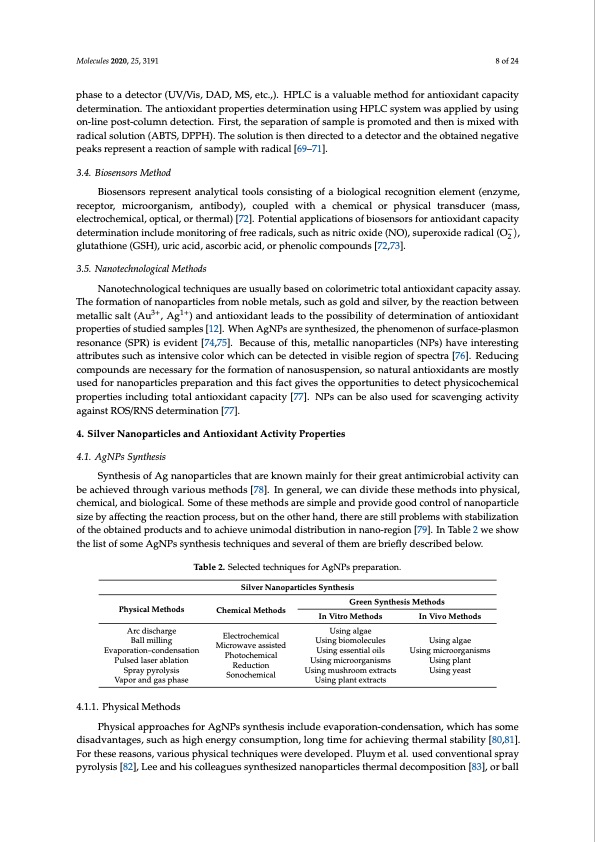
PDF Publication Title:
Text from PDF Page: 008
Molecules 2020, 25, 3191 8 of 24 phase to a detector (UV/Vis, DAD, MS, etc.,). HPLC is a valuable method for antioxidant capacity determination. The antioxidant properties determination using HPLC system was applied by using on-line post-column detection. First, the separation of sample is promoted and then is mixed with radical solution (ABTS, DPPH). The solution is then directed to a detector and the obtained negative peaks represent a reaction of sample with radical [69–71]. 3.4. Biosensors Method Biosensors represent analytical tools consisting of a biological recognition element (enzyme, receptor, microorganism, antibody), coupled with a chemical or physical transducer (mass, electrochemical, optical, or thermal) [72]. Potential applications of biosensors for antioxidant capacity determination include monitoring of free radicals, such as nitric oxide (NO), superoxide radical (O−2 ), glutathione (GSH), uric acid, ascorbic acid, or phenolic compounds [72,73]. 3.5. Nanotechnological Methods Nanotechnological techniques are usually based on colorimetric total antioxidant capacity assay. The formation of nanoparticles from noble metals, such as gold and silver, by the reaction between metallic salt (Au3+, Ag1+) and antioxidant leads to the possibility of determination of antioxidant properties of studied samples [12]. When AgNPs are synthesized, the phenomenon of surface-plasmon resonance (SPR) is evident [74,75]. Because of this, metallic nanoparticles (NPs) have interesting attributes such as intensive color which can be detected in visible region of spectra [76]. Reducing compounds are necessary for the formation of nanosuspension, so natural antioxidants are mostly used for nanoparticles preparation and this fact gives the opportunities to detect physicochemical properties including total antioxidant capacity [77]. NPs can be also used for scavenging activity against ROS/RNS determination [77]. 4. Silver Nanoparticles and Antioxidant Activity Properties 4.1. AgNPs Synthesis Synthesis of Ag nanoparticles that are known mainly for their great antimicrobial activity can be achieved through various methods [78]. In general, we can divide these methods into physical, chemical, and biological. Some of these methods are simple and provide good control of nanoparticle size by affecting the reaction process, but on the other hand, there are still problems with stabilization of the obtained products and to achieve unimodal distribution in nano-region [79]. In Table 2 we show the list of some AgNPs synthesis techniques and several of them are briefly described below. Physical Methods Arc discharge Ball milling Evaporation–condensation Pulsed laser ablation Spray pyrolysis Vapor and gas phase 4.1.1. Physical Methods Chemical Methods Electrochemical Microwave assisted Photochemical Reduction Sonochemical In Vitro Methods Using algae Using biomolecules Using essential oils Using microorganisms Using mushroom extracts Using plant extracts In Vivo Methods Using algae Using microorganisms Using plant Using yeast Table 2. Selected techniques for AgNPs preparation. Silver Nanoparticles Synthesis Green Synthesis Methods Physical approaches for AgNPs synthesis include evaporation-condensation, which has some disadvantages, such as high energy consumption, long time for achieving thermal stability [80,81]. For these reasons, various physical techniques were developed. Pluym et al. used conventional spray pyrolysis [82], Lee and his colleagues synthesized nanoparticles thermal decomposition [83], or ballPDF Image | Antioxidant Activity Determination of Silver Nanoparticles

PDF Search Title:
Antioxidant Activity Determination of Silver NanoparticlesOriginal File Name Searched:
molecules-25-03191.pdfDIY PDF Search: Google It | Yahoo | Bing
Turbine and System Plans CAD CAM: Special for this month, any plans are $10,000 for complete Cad/Cam blueprints. License is for one build. Try before you buy a production license. More Info
Waste Heat Power Technology: Organic Rankine Cycle uses waste heat to make electricity, shaft horsepower and cooling. More Info
All Turbine and System Products: Infinity Turbine ORD systems, turbine generator sets, build plans and more to use your waste heat from 30C to 100C. More Info
CO2 Phase Change Demonstrator: CO2 goes supercritical at 30 C. This is a experimental platform which you can use to demonstrate phase change with low heat. Includes integration area for small CO2 turbine, static generator, and more. This can also be used for a GTL Gas to Liquids experimental platform. More Info
Introducing the Infinity Turbine Products Infinity Turbine develops and builds systems for making power from waste heat. It also is working on innovative strategies for storing, making, and deploying energy. More Info
Need Strategy? Use our Consulting and analyst services Infinity Turbine LLC is pleased to announce its consulting and analyst services. We have worked in the renewable energy industry as a researcher, developing sales and markets, along with may inventions and innovations. More Info
Made in USA with Global Energy Millennial Web Engine These pages were made with the Global Energy Web PDF Engine using Filemaker (Claris) software.
Infinity Turbine Developing Spinning Disc Reactor SDR or Spinning Disc Reactors reduce processing time for liquid production of Silver Nanoparticles.
| CONTACT TEL: 608-238-6001 Email: greg@infinityturbine.com | RSS | AMP |